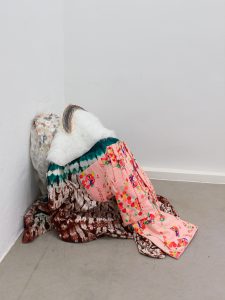12 Okt DON’T SHOOT THE PERFORMER; ISABELLA FÜRNKÄS AND THE PERFORMATIVE OF THE OTHER
Don’t Shoot The Performer;
Isabella Fürnkäs and the Performative of the Other
Crowd surfing through the valley of the dolls that is a Berlin performance audience I finally found a way to utilize the 1 meter long legs my Greek mother so gracefully blessed me with and managed to find a small opening between the long wool winter coats and beer bottles of the first row. The piece was scheduled on the occasion of a group show in an off space at the Postdamer Strasse out in an open terrace, neatly stuck between its concrete neighbors and overlooked by a nike billboard. Two guys, dressed in black leather *or at least leather looking/hearing/feeling* pants, stretch and start conversing with one another. A microphone system is attached to each of them allowing the audience to hear every last detail of the spoken words, as well as the screeching noises from their contact. They interact with each other, utilize the negative space around them and use just a simple selection of props during their ritual. At some point their breathing turns heavy
Isabella Fürnkäs’ process deals with the aftermath of a delicate identity crisis that cannot play nice anymore and has reached a boiling point making the need of pointing some fingers and raising some eyebrows even more demanding than ever. Communication practices, highly linked to a long one sided evolutionary history of western thinking, have been strictly canonized within a clearly defined language cosmos. Embodied identities and subject roles have for so long been diminished into nothing more than just a mere Epiphenomenon of human cognition; a world where the almighty power of the logos still rains with an iron fist, outranking the body, the space and the Machine.
Don't Shoot The Performer; Isabella Fürnkäs and the Performative of the Other Crowd surfing through the valley of the dolls that is a Berlin performance audience I finally found a way to utilize the 1 meter long legs my Greek mother so gracefully blessed me with and managed to find a small opening between the long wool winter coats and beer bottles of the first row. The piece was scheduled on the occasion of a group show in an off space at the Postdamer Strasse out in an open terrace, neatly stuck between its concrete neighbors and overlooked by a nike billboard. Two guys, dressed in black leather *or at least leather looking/hearing/feeling* pants, stretch and start conversing with one another. A microphone system is attached to each of them allowing the audience to hear every last detail of the spoken words, as well as the screeching noises from their contact. They interact with each other, utilize the negative space around them and use just a simple selection of props during their ritual. At some point their breathing turns heavy Isabella Fürnkäs’ process deals with the aftermath of a delicate identity crisis that cannot play nice anymore and has reached a boiling point making the need of pointing some fingers and raising some eyebrows even more demanding than ever. Communication practices, highly linked to a long one sided evolutionary history of western thinking, have been strictly canonized within a clearly defined language cosmos. Embodied identities and subject roles have for so long been diminished into nothing more than just a mere Epiphenomenon of human cognition; a world where the almighty power of the logos still rains with an iron fist, outranking the body, the space and the Machine in

Isabella Fürnkäs | Hungry Mice & Salty Pepper | 2017
›Unpredictable Liars (6)‹
mixed media, fabric, oil sticks on paper, dimensions variable
2017
The construction of the Other, understood as a differentiated Self, becomes a vital component of the piece; a text written in manner resembling a monologue, and yet performed by two individual bodies, in such a way, so that the speech acts and embodied identities, all end up interacting with one another. In other words: there is no “I” of a strong and definitive one performer to be found, but an intricate assemblage of scattered structures waiting to come alive.
The Nike Billboard stares right back at me.


